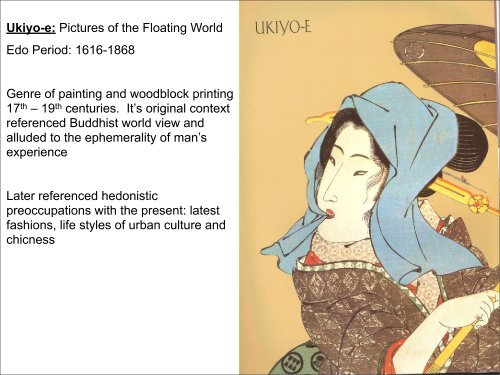Ukiyo-e: Pictures of the Floating World Edo Period ... - GSAVisualarts
Ukiyo-e: Pictures of the Floating World Edo Period ... - GSAVisualarts
Ukiyo-e: Pictures of the Floating World Edo Period ... - GSAVisualarts
Create successful ePaper yourself
Turn your PDF publications into a flip-book with our unique Google optimized e-Paper software.
<strong>Ukiyo</strong>-e: <strong>Pictures</strong> <strong>of</strong> <strong>the</strong> <strong>Floating</strong> <strong>World</strong><br />
<strong>Edo</strong> <strong>Period</strong>: 1616-1868<br />
Genre <strong>of</strong> painting and woodblock printing<br />
17 th – 19 th centuries. It’s original context<br />
referenced Buddhist world view and<br />
alluded to <strong>the</strong> ephemerality <strong>of</strong> man’s<br />
experience<br />
Later referenced hedonistic<br />
preoccupations with <strong>the</strong> present: latest<br />
fashions, life styles <strong>of</strong> urban culture and<br />
chicness
Standard Print sizes:<br />
o-oban (large oban)<br />
60 cm x 32 cm<br />
24 in x 12.8 in<br />
oban<br />
39 cm x 26 cm<br />
15.6 in x 10.4 in<br />
nagaban<br />
52 cm x 25 cm<br />
20.8 in x 10 in<br />
chuban<br />
28 cm x 15 cm<br />
11.2 in x 6 in<br />
hosoban<br />
30 cm x 15 cm<br />
12 in x 6 in<br />
Hashira-e (pillar print)<br />
70 cm x 12 cm<br />
28 in x 4.8 in
After 1789 <strong>the</strong> shogunate established measures requiring that all prints be<br />
inspected and stamped with <strong>of</strong>ficial seals <strong>of</strong> approval ( a function <strong>of</strong> <strong>the</strong><br />
publishers’ association
1) Process <strong>of</strong> producing and distributing <strong>the</strong> prints are compared to <strong>the</strong> process<br />
<strong>of</strong> wet rice cultivation (a <strong>the</strong>me introduced fr. China)<br />
2) The artists (including Utamaro himself have been depicted in <strong>the</strong> guise <strong>of</strong><br />
famous Geisha
1) Publisher (hanmoto) contacts an artist with a proposal for a new project<br />
2) <strong>Ukiyo</strong>-e artist (e-shi) produces a black-ink preliminary design (hanshita-e) on thin<br />
paper and sends it to <strong>the</strong> Publisher.<br />
3) Publisher applies for permission to proceed and <strong>the</strong> association censors design, if<br />
it is accepted it is stamped with seals <strong>of</strong> approval and returned to <strong>the</strong> publisher<br />
4) Publisher <strong>of</strong>fers a commission to prepare woodblock fr <strong>the</strong> design to an engraver<br />
.<br />
5) Engraver (hori-shi) spreads design over woodblock <strong>of</strong> hard cherry and tracing <strong>the</strong><br />
lines carves a woodblock that duplicates <strong>the</strong> design and has register marks (kento) for<br />
color printing<br />
6) Printer (suri-shi) prints a number <strong>of</strong> monochrome prints for <strong>the</strong> artist to indicates<br />
colors he wants for each part <strong>of</strong> <strong>the</strong> print
1) Publisher indicates <strong>the</strong> number <strong>of</strong> colors to be used according to his budget<br />
2) Artist indicates on <strong>the</strong> monochrome prints <strong>the</strong> portions to be colored, one sheet for<br />
each color<br />
3) Engraver carves woodblocks for each <strong>of</strong> <strong>the</strong> colors selected by <strong>the</strong> artist<br />
4) Printer completes first samples <strong>of</strong> complete print<br />
5) Artist makes any needed corrections<br />
6) Printer prints as many copies as <strong>the</strong> publisher has commissioned<br />
7) Publisher begins to sell finished prints in his print shop
Kitagawa Utamaro,<br />
The Cultivation <strong>of</strong> <strong>Edo</strong>’s Famous Produce,<br />
<strong>the</strong> Brocade Woodblock Print,<br />
ca. 1800 oban size, published by Tsuruya
Prints were a cooperative effort btwn<br />
artists, engravers, printers, and<br />
publishers<br />
Adachi Institute <strong>of</strong> Woodblock Prints
Print 1: artist’s outline printed in sumi (black ink)
Prints 2-5: light colors that cover fairly wide areas <strong>of</strong> <strong>the</strong> print
This is what <strong>the</strong> print wood look like after going trough <strong>the</strong> above steps
Prints 6-9 are used to print <strong>the</strong> scene outside <strong>the</strong> window
This is how <strong>the</strong> print would look after undergoing steps 1-9
Steps 10-13: <strong>the</strong>se woodblocks are primarily used to apply <strong>the</strong> colors<br />
<strong>of</strong> <strong>the</strong> kimono worn by <strong>the</strong> woman standing to <strong>the</strong> extreme right
After steps 1-13. The colors are still primarily light ones, but <strong>the</strong> print is<br />
nearing completion
Blocks 14-17 apply brilliant colors remaining for <strong>the</strong> female figures<br />
kimonos and <strong>the</strong> color <strong>of</strong> <strong>the</strong> furnishings <strong>of</strong> <strong>the</strong> room
The last block prints <strong>the</strong> title and <strong>the</strong> artist’s signature in heavy black ink
The complete print (colors exaggerated on <strong>the</strong> right)
Hishikawa Moronobu<br />
Okumura Masanobu<br />
Suzuki Harunobu<br />
Utagawa Toyoharu<br />
Torii Kiyonaga<br />
Kitagawa Utamaro<br />
Utagawa Toyokuni<br />
Toshusai Sharaku<br />
Katsushika Hokusai<br />
Utagawa School:<br />
Utagawa Kunisada<br />
Utagawa Kuniyoshi<br />
Utagawa Hiroshige




